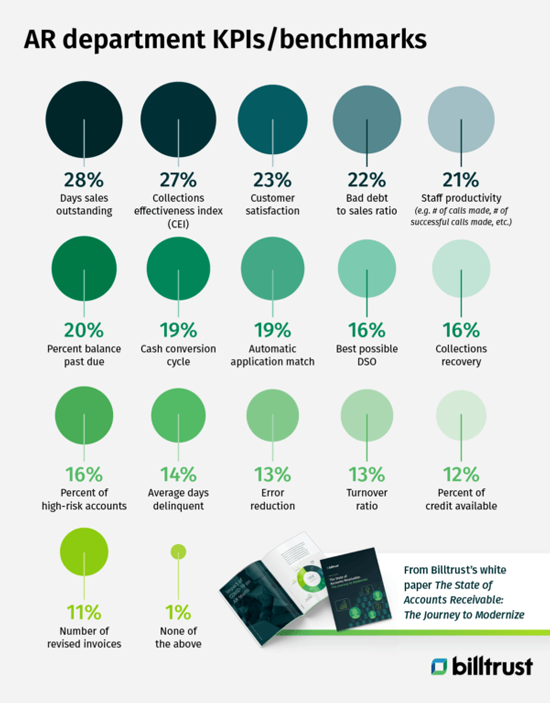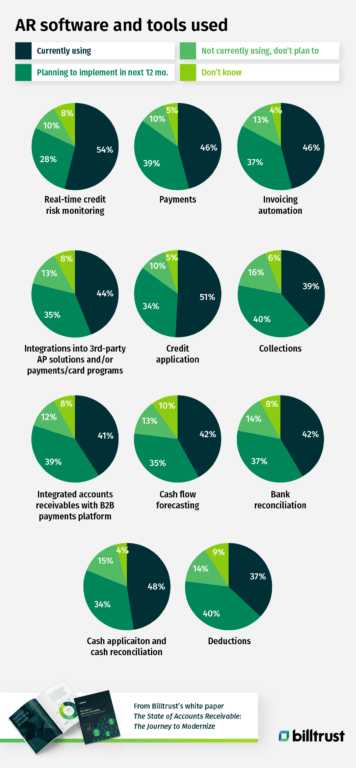As we’ve explored previously, accounts receivable (AR) is undergoing a profound digital transformation. How are B2B businesses across multiple industries dealing with this change?
To find answers to this question, Biltrust commissioned Paradoxes, Inc. to conduct an extensive research study, The State of Accounts Receivable: The Journey to Modernize.
The resulting white paper provides a unique, layered view of the current AR landscape. It supplies key findings that may help your organization as it faces the challenges of the pandemic, confronts new impacts caused by other unforeseen events and prioritizes its investments in technology and automation.
Measuring success
How do AR teams measure their success? The respondents covered a number of benchmarks, with the most popular metrics being Days Sales Outstanding (DSO), collections effectiveness, customer satisfaction, bad debt-to-sales ratio and staff productivity, in that order.

Almost 50% of respondents indicated their organization's current "best case" DSO is 31-45 days (with 31% indicating that it's 30 days or less, and 22% claiming it's 46 days or more).
"DSO is looked at very closely. Being multinational, we have different circumstances in different countries. We have a blended DSO across countries. There are secondary benchmarks like invoices paid and past due percentage, and those are reported on. But DSO is the primary KPI."
Global Director, Credit and AR, Industrial Manufacturing
Why does this matter? This number becomes particularly important when you consider that a high DSO can translate into a cash flow problem for the organization in question, leading us directly to the next point.
COVID-19 and cash flow
While the shift to remote work had the most significant impact on AR teams, another area that was highlighted was a slowdown in cash flow.
As Forbes highlights, the recession of 2008-2009 was followed by a steady recovery and growing capital market. This went hand-in-hand with an increase in investment dollars:
"Companies attained billion-dollar valuations even though they’ve never been profitable. To some degree, this denigrates the view of a cash flow-positive business — a problem that became evident when large swaths of companies completely stopped nearly all incoming revenue streams in 2020."
Not ideal. However, this rather unfortunate situation serves to teach us how to prioritize driving cash into the business. So as your business moves forward, whether it's in recovery mode or trying to be a better competitor in dynamic markets, it's crucial to take a clear-eyed look at your current AR practices and tools.
The systems and tools in use
According to the study, roughly 50% of AR teams have adopted real-time credit risk monitoring, credit application and cash application software and tools.
After these, payment solutions, invoicing automation and integrations into third-party accounts payable (AP) solutions and/or payment/card programs are the most prevalent technologies used.
Perhaps more importantly, many teams are planning to implement and use new technologies in the next 12 months such as collections, deductions and payments solutions, followed by integration of AR with B2B platforms. This shows a positive outlook for the future, as organizations place importance on cash flow using better software and tools in their accounts receivable (AR) departments.

How is AR perceived?
Currently, survey respondents believe there is high satisfaction with AR teams among both their executives and the customers they serve. 82% said their executives are very or somewhat satisfied and 84% of customers are very or somewhat satisfied with their function.
However, 75% of participants believe their executives view them primarily as a task-focused execution team. And only 25% believe they are considered a strategic partner in the business.
Moreover, 82% believe their C-suite views AR as a function that "keeps their finances in order" versus "an innovative finance organization."
An area of consequence in the year ahead is using AR data for decision-making. On a positive front, 65% of AR teams believe the importance of AR data for decision-making will increase over the next 12 months for their team.
However, only 47% feel that their AR data is highly organized and accessible. This will pose a challenge for many AR teams when it comes to deriving valuable insights from their data.
The opportunity ahead?
Clearly, as companies press forward, AR teams need to focus on organizing their data for accessibility and implementing new technologies that will allow them to demonstrate their strategic value to the organization. Having a consistent, automated collections platform and process in place reduces slowdowns and accelerates cash flow.
Interested in the complete set of insights contained in the report? Download it here.
Discover the future of the CFO at Billtrust Insight 2022
The role of the CFO and the background expected of the "next generation" of CFOs are evolving in surprising ways. At our upcoming Billtrust Insight 2022 conference, explore the CFO’s Office of the Future, as we unveil a new study that will provide key insights into the changes underway, and how these will impact organizations today and for years to come.

